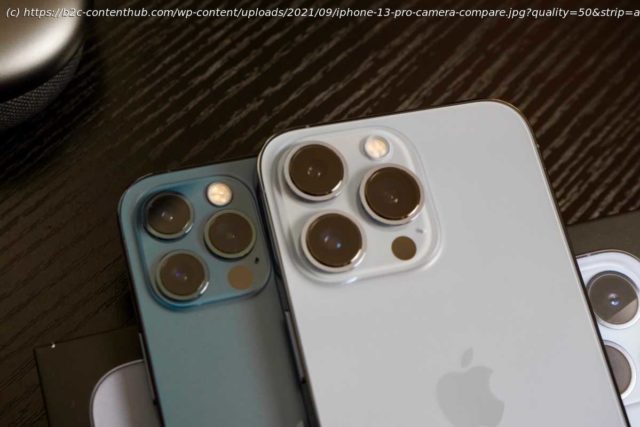None of the iPhone 13 Pro’s improvements are surprising, but they still manage to impress.
The iPhone 13 Pro is absurdly fast, has a killer camera system, the display is fantastic, and the battery life is longer than ever. We have a few nits to pick, but Apple has made it easy to love its latest “Pro” iPhone. Early in the 2021 iPhone rumor lifecycle, it was reported that Apple might call this year’s offering the iPhone 12s. Previous “S” model iPhones —such as the iPhone 6s or iPhone Xs—would generally keep the same design and features of the previous year’s model, with a faster processor, better camera, and a single standout new feature. Though Apple didn’t go with iPhone 12s name, it may have been a fitting monicker, at least where the Pro models are concerned. The iPhone 13 Pro is essentially the iPhone 12 Pro with a faster processor, better camera, and one big standout feature (ProMotion). But to treat it so reductively is to do it a disservice. The scale of improvements here are noteworthy, and the gap between Pro and non-Pro models is significant. This is essentially the iPhone 12 Pro with ProMotion, a better camera system, faster performance, and better battery life. That’s not a surprising or particularly innovative set of improvements, but it still adds up to one hell of a nice iPhone. While the iPhone 13 Pro looks a lot like the iPhone 12 Pro at a glance, and indeed is a sort of fraternal twin, there are differences. Some are subtle, others jump right out at you. The iPhone 13 Pro and Pro Max are nearly the exact same physical dimensions as the iPhone 12 Pro models they replace. These are heavy phones, just as their predecessors were; a natural side-effect of the stainless steel frame. Not much has changed when it comes to durability, not that we’re complaining. The iPhone 13 Pro still carries an IP68 water and dust resistance rating, and is rated for up to 30 minutes at a depth of six meters. It’s got the same Ceramic Shield front glass, too. The silver, graphite, and gold colors from last year return, but Pacific Blue has been replaced with Sierra Blue, a much lighter shade that looks nice enough, though I prefer last year’s darker hue. IDG / Jason Cross While USB-C is creeping its way through all of Apple’s other products—it’s now the only port on MacBooks, the M1 iMac, iPad Pros, the iPad Air, and iPad mini—the company still refuses to move the iPhone line to this more universal plug. If you have a bunch of Apple gear, you have Lightning and USB-C charging cables. And for no good reason, really. Come on, Apple. It’s time. Speaking of charging, there’s not much new there. You still get a USB-C to Lightning cable in the box but no power adapter or headphones. Charging performance is unchanged: you get up to 50 percent charge in 30 minutes with a 20W USB-C adapter. Storage options still start at 128GB, with options for 256GB,512GB, and now a new 1TB option. That’s an obscene amount of storage for a phone and really only worthwhile if you think you’re going to shoot a lot of video (especially in ProRes format). The design changes you will notice right away are the smaller notch and much bigger camera module. The rear camera area is dramatically larger and sticks out further, to the point where you might not actually be able to put your phone on some stands or car mounts without a case that makes the camera bump sit flush. Note that most of Apple’s first-party cases do not! IDG The notch on the front where the speaker and TrueDepth sensors reside is now 20 percent narrower, which is nice, but the extra screen space is going entirely to waste. You don’t get any additional icons or information in the status bar. Surely Apple must know that everyone wants the battery percentage back, right? This year, the iPhone 13 Pro and Pro Max have the exact same camera system and software features, so you don’t have to buy the bigger one to get the better camera. This is the right approach, and we hope Apple continues it in the future. The first thing you’ll notice when you pick up an iPhone 13 Pro is just how smooth everything feels. Swipes, scrolls, interface animations… Apple was always good at this stuff, but the responsiveness and smoothness of the iPhone 13 Pro is on another level. That’s thanks to a new OLED display that is more power efficient and includes ProMotion technology similar to that found on the iPad Pro. Rather than always refreshing at 60Hz, the display can go as low as 10Hz and as high as 120Hz. There are no settings for this; the phone continually adjusts the display refresh based on the content on screen. Play back a 24fps movie and the display will lock to 24Hz. Read static text and it’ll drop to 10Hz. Start scrolling and swiping around and it’ll ramp up to 120Hz. Many apps that use standard iOS frameworks for scrolling and full-screen transitions will automatically take advantage of this, looking and feeling smoother as a result. Apps like games will require an update to take advantage of ProMotion, and there are currently some limitations there that don’t exist for iPad developers and will hopefully be lifted in future software updates. The upshot of all this is that the display is smoother and faster when it matters most and more power efficient the rest of the time. This has an overall positive impact on battery life, which we’ll get to later. The display is brighter, too: it goes up to 1,000 nits in standard use, up from 800 on the iPhone 12 Pro (the max is still 1,200 nits for HDR content). We’ve had some very bright and hot days here in Sacramento lately and you can clearly see the difference out in direct sunlight. In other circumstances, the screen looks just like the excellent iPhone 12 Pro display. IDG Enthusiasts have been begging for ProMotion on the iPhone ever since it landed on the iPad Pro four years ago. It’s just as good as we’ve always expected, and a clear differentiator between the Pro and standard iPhone 13. Now it just needs to come to the MacBook Pro and iMac! The A14 found in last year’s iPhone 12 is faster than any processor found today in any Android smartphone. No Qualcomm Snapdragon or Samsung Exynos can come close to last year’s best chip from Apple. And now the A15 is faster. In some ways, much faster. Like the A14, the A15 is made with a 5nm manufacturing process from TSMC, and still sports two high-performance cores and four high-efficiency cores. Nonetheless, in our benchmark tests we found the A15 delivers about 8-10 percent faster single-core CPU performance, and 15-20 percent better multi-core CPU performance. The GPU is where things get really interesting. In the iPhone 13 and iPhone 13 mini, the A15 still has a four-core GPU.






